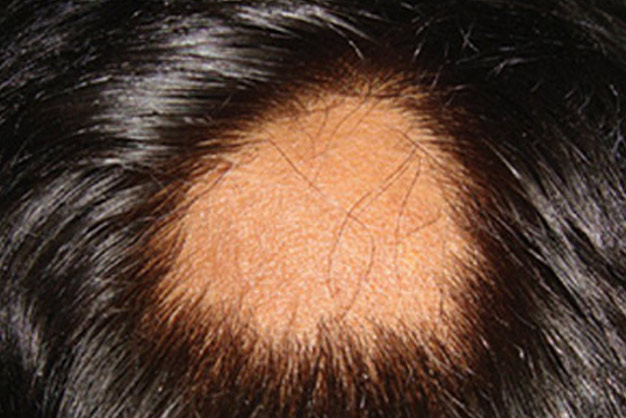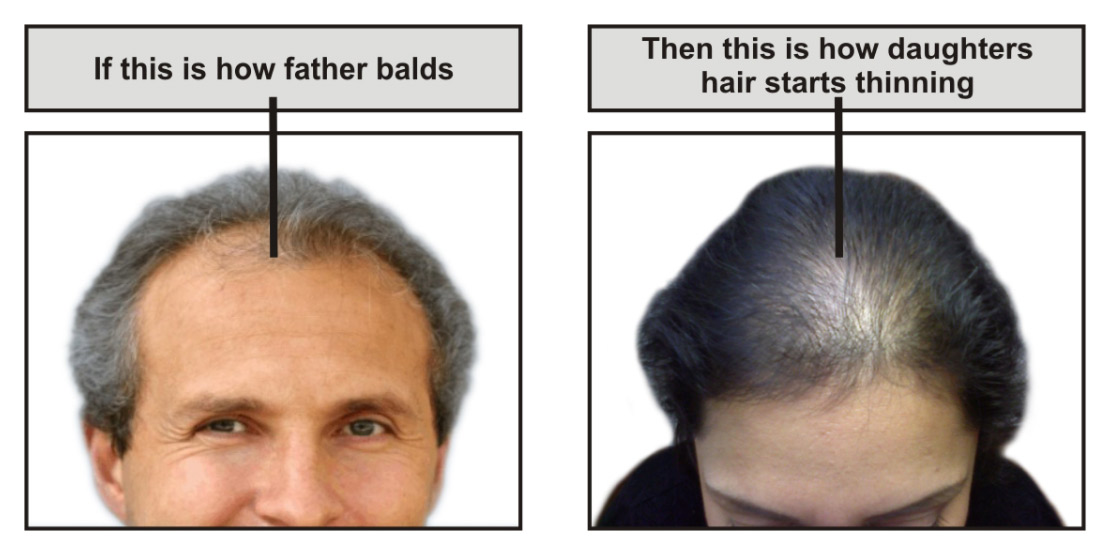Types of Hair Loss
Male Pattern Baldness – Men’s Hair Loss
Pattern hair loss in men occurs due to a combination of genetics and male hormone. The hair loss or hair thinning usually begins from the temples and top of the head. Each strand progressively become thinner, a process called miniaturization. Eventually only a rim of hair at the sides and rear of the head remains.
This pattern includes a retreating hairline with thinning around the crown with ultimate bald spots. Moreover, this has been attributed to genetics as well as testosterone influence.
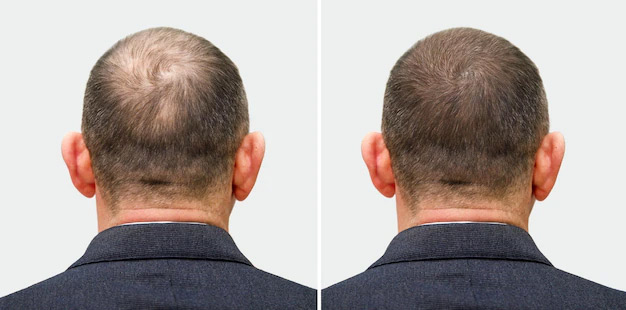
Why are men balding at an early age as compared to their parents?
Latest studies have shown that men are going bald at an earlier age as compared to their parents. There are many cases wherein the patients report of balding in their early 20’s and a closer look at their family history reveals that their parents had suffered baldness much later in life by the age of 50 or 60.
The study was carried out at the University of London. In the study, samples of hair were taken from people staying in different areas. Scientists conducting the research found that samples removed from more polluted areas showed higher degrees of “oxidative stress”, a process known to cause damage to follicular hair growth leading to faster baldness.
This clearly shows that hereditary tendency alone does not play a role in premature baldness. It is the combination of hereditary factors and the added influence of environmental factors like change of water, traveling, exposure to toxins, dietary deficiencies, stress etc which hasten the process of baldness in which it is also referred in American Academy of Dermatology Association.
As the number of factors causing hair loss increases, so does the severity of hair loss. Refer to the below table for more details:-
| Factors affecting hair loss | Effect on Hair |
|---|---|
| Hereditary alone | Hair Loss after 40-45 Gradual baldness sets in over 5-10 years |
| Hereditary + Stress | Hair Loss between the age of 30-40 yrs Baldness results within 3-5 yrs of onset |
| Hereditary + Stress + Fungal Infections | Hair Loss in early & mid 20s Baldness by the age of 30 yrs |
| Hereditary + Stress + Fungal Infections + Change of water | Hair loss starts in teenage life Baldness results by age of 25 |
The above scenarios are just some examples of how various causes can combine together playing havoc on your hair, almost like “a candle burning at both the ends”. The exact combination varies from patient to patient and to treat any case of hair loss, the exact combination of factors affecting hair loss need to be elicited. This is one of the reasons why many over-the-counter products like oils and shampoos do not work for everyone, because they are not tailor made for specific cases and being general in nature, they are not equipped to tackle all the factors in a particular case. The research has confirmed the belief that a holistic approach keeping genetics and environmental factors both in mind while treating a case gives a better long term control of hair loss.
Female Pattern Baldness – Women’s Hair Loss
Women are increasingly catching up with men in the field of baldness. Although the risk factors are common for both men and women, in the earlier days women were not as prone to baldness as men. The reason being, the presence of estrogen and progesterone has a protective effect on hair and enables good growth. Furthermore in earlier times women mostly stayed indoors and were not exposed to environmental triggers. Therefore even with hereditary tendencies, women did not suffer from baldness easily. On the other hand, men have not only been weighed down by hereditary influences but have also been exposed to outside triggers like work pressure, pollution, change of water and thus baldness developed faster in men. But the scenario now has changed. Recent reports have shown increasing incidences of Female pattern baldness in women. This may be a sign of changing times as more and more women are now getting out of homes, taking up challenging roles, traveling overseas & getting exposed to the same outside triggers and are therefore becoming as vulnerable to baldness as men. In fact women are not only going bald faster but also at a younger age.

What are the symptoms of Pattern Hair loss in women?
Female pattern baldness is the most common form of baldness seen in women. In this there is not much hair loss, but each hair progressively starts thinning out. This is called miniaturization in which the individual hairs start decreasing in size, in diameter and in length until they eventually disappear, making the scalp visible.
The hair thinning goes undetected in the early stages due to the length of the hair but progressively gets worse which is also referred in American Academy of Dermatology Association. The woman is often not sure whether to worry or not till it is too late. This is where a Tricho Analysis can help. It can detect these initial signs of hair thinning so that a suitable line of treatment can be started in the early stages.
What are the causes of Pattern Hair loss in women?
Diffuse Unpatterned Alopecia – DUPA
“Not much hair fall…yet getting bald”
Patients with Diffuse Unpatterned Alopecia (DUPA) develop hair thinning not only in the front and top of the scalp, but also on the sides and back (the sides and the back of the head are areas that are traditionally considered safe from hair loss). There is diffuse miniaturization of the hair from all over the scalp at the same time. Miniaturization refers to a process wherein the individual strands of hair progressive become shorter and thinner, until they almost disappear.
Very often in DUPA, there is not much hair loss. The hair just begins to thin from all over the scalp. As there is not much hair loss, the patient often does not notice anything amiss. It is the friends or relatives who notice the signs of thinning and bring it to the patient’s attention.
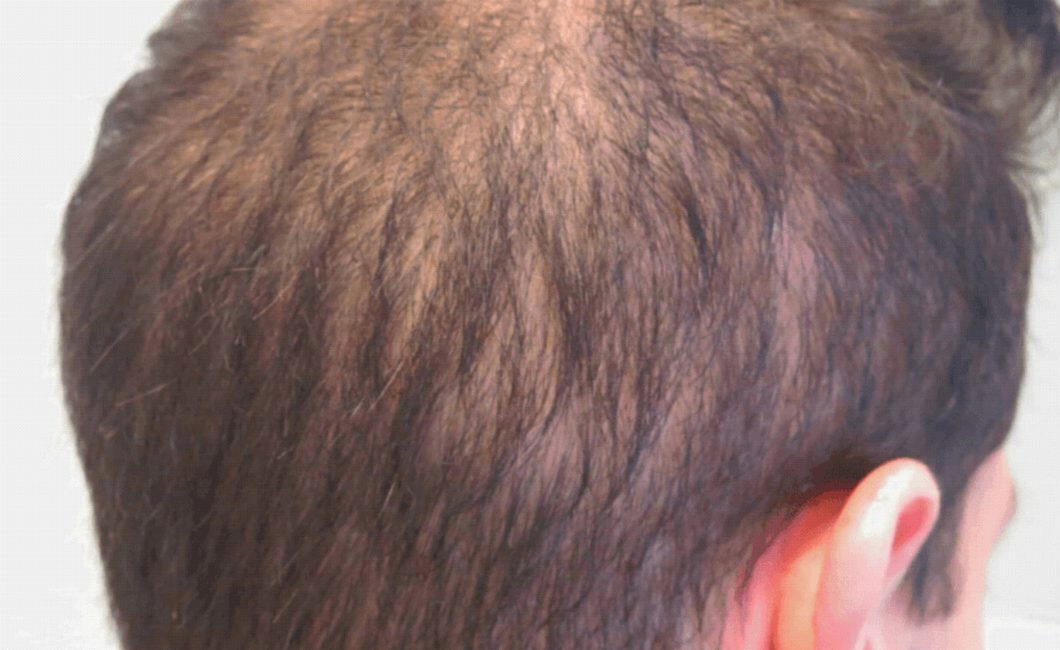
What are the symptoms of Diffuse Unpatterned Alopecia?
Unlike Pattern Baldness, in DUPA, we see no pattern. The thinning may start from the sides and back of the head, and then may spread all across the head which is also referred in American Academy of Dermatology Association.
DUPA can affect both men and women. The differences have increasingly blurred with passage of time. DUPA is also seen in Chronic Telogen Effluvium where a pre-existing hereditary hair loss condition gets exacerbated due to environmental factors like frequent change of water resulting from traveling or relocating every 1-2 years, long term stress or a chronic illness. The result, the person starts balding in his early 20’s or 30’s instead of the usual thinning seen with advancing age. In women, DUPA is often precipitated by a hormonal trigger. For example post-childbirth & the menopausal phase of life are the commonest triggers.
Alopecia Areata – Hair Loss in patches
It is a condition where a person loses hair in spots or patches from any part of the scalp or body. Alopecia Areata can be infectious or auto-immune in nature.
Infectious Alopecia Areata
Amongst various scalp infections, the one that causes hair loss in patches is Ringworm. Ringworm is a fungal infection that can occur anywhere on the body. Wherever it develops – on the scalp, beard or on the body, it causes circular patches of hair loss and is called Tinea Capitis. The fungus gets into the hair fibers in the affected area and these hairs become brittle and break off easily leaving a bald patch.
Ringworm is contagious. It can be passed from one person to another by direct skin-to-skin contact. You can also catch ringworm through contact with contaminated items such as combs, unwashed clothing, pillow covers and shower or pool surfaces. You can catch it from pets that carry the fungus, and cats in particular are common carriers.
Treatment for ringworm varies depending on the particular fungus involved.

Auto-immune Alopecia Areata
In the auto-immune variety, the body’s immune system attacks and destroys its own hair follicles resulting in patchy hair loss. Unlike the ringworm infection, the auto-immune alopecia areata is not contagious.
In the auto-immune variety, the trigger could be an infection which can be fungal, viral or bacterial. The infection may not be severe but it makes the body produce certain antibodies. The function of these antibodies is to kill the infection but instead it starts destroying the hair follicles. From a localized area, the antibodies then circulate throughout the body causing widespread destruction of hair follicles.
It is not very clear as to why the immune system malfunctions in some people and not in others. But people with a family history are more likely to suffer from this condition. It can equally affect both men and women and is commonly found in people younger than 20.
Auto-immune Alopecia Areata has 2 types. One is the scarring alopecia in which the skin is thickened and scarred with loss of hair follicles. The second is the non-scarring alopecia wherein the hair strand is lost but the follicles are intact, making it the reversible type.
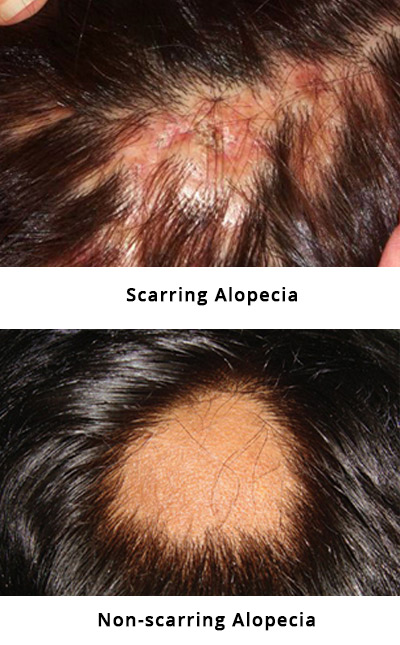
How is Alopecia Areata diagnosed?
Diagnosis is made on the basis of the presenting symptoms. Tricho Analysis shows small exclamation-mark hairs. Characteristic black dots which are the destroyed hairs in the hair follicle opening can also be seen.
What is the treatment for Alopecia Areata?
Treatment is depending on the type and cause of alopecia. The condition can run an erratic course with frequent recurrences and remissions. It can have a sudden onset starting with a single patch, overnight multiplying into multiple patches and can spread like wild fire leading to hair loss from all over body. For example, in a case of a young girl about the age of 18 years old, living in rural Karnataka, the condition started with a single bald patch on her scalp. In the next few days each time she washed or combed her hair, a chunk of hair strands around 1000-2000 hairs simple fell off, almost as if the hairs were glued to the scalp and the glue was wearing off. Within 3 months, from nearly having waist long hair, she ended up with complete hair loss, not a single strand of hair on any part of her body. This is the rapidity and suddenness with which this condition is seen. Most cases however are not severe, but the ability of this condition to spread or relapse even while on medication remains unmatched by any other hair disorder. Alopecia Areata in stages one and two shows the best response and as it spreads to the other parts of the body the chances of effective control come down.
Telogen Effluvium – Sudden hair loss
The name itself is quite suggestive, derived from a combination of 2 words- Telogen which refers to the falling phase of the hair and Effluvium which means to “evaporate”. Thus in this condition the hair fall is so rapid, that one can almost say that the hair simply “evaporates” from the head, leading to substantial thinning or baldness in a very short span of time.
Telogen effluvium is triggered when a major stress or hormonal change interrupts and stops the growth of some hairs. This causes a large number of hairs to enter the telogen or the resting phase all at once. It takes 1-3 months for the affected hairs to fall out after their growth has stopped. Telogen effluvium is therefore usually seen 1-3 months after a major stress to the body.

What causes Telogen Effluvium?
Some of the known triggers are –
After childbirth
Women typically complain of sudden hair loss in bunches which starts overnight. What causes the panic is that simply touching the hair also makes a lot of strands fall out, which is also referred in American Academy of Dermatology Association.
Acute stress with lack of sleep
As seen in students during exams. In such cases the hair loss develops suddenly almost overnight and in such high numbers that the hairs loss itself causes more stress to the patient.
After acute illness or accident or a major operation
The hair loss may start few months after the acute illness. For example let’s say you suffered from a severe flu attack or Typhoid in January and recovered from the same within 10 days. Your hair loss can then start anytime around April, at a time when you are actually in the best of health.
Crash dieting
You may have switched to a new diet and lost a certain number of Kilos. Your hair loss may start 1-3 months, much after you have resumed your normal diet.
Change of water or frequent travel
As seen in relocating out of hometown or frequent changes in water due to work related travel.
Often Telogen Effluvium may superimpose on other hair loss conditions worsening the situation. For example a person having hereditary tendency to hair loss has also been exposed to frequent travel to different locations. Frequent travel causes Telogen Effluvium, which then prematurely triggers the pre-existing heredity condition leading to baldness. This is why we see a lot of men and women prematurely balding, at a much younger age as compared to the age when their parents lost hair.
Most patients of Telogen Effluvium experience a lot of panic over the hair fall. However it is important to understand that unlike some other hair and scalp conditions, Telogen Effluvium is temporary and the hair growth usually recovers. After a short time, new hairs grow from the hair follicles as usual. A normal pattern and thickness of hair usually returns within a few months once these new hairs are established.
The treatment involves reversing the ratio of growing hair to resting hair to the normal 9:1, which in turn normalizes the hair fall.



